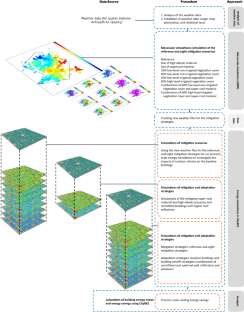2024-01-12 ニューサウスウェールズ大学(UNSW)
◆研究は都市全体に熱緩和技術を実装した場合のエネルギー利益を初めて検証し、適切な技術の組み合わせにより都市の環境温度を低下させ、冷却ニーズを最大で16%削減できることを示している。
<関連情報>
- https://newsroom.unsw.edu.au/news/art-architecture-design/reflective-materials-and-irrigated-trees-study-shows-how-cool-one-world
- https://www.nature.com/articles/s44284-023-00005-5
都市規模での熱緩和技術のエネルギー影響を定量化する Quantifying the energy impact of heat mitigation technologies at the urban scale
Shamila Haddad,Wanni Zhang,Riccardo Paolini,Kai Gao,Muzahim Altheeb,Abdulrahman Al Mogirah,Abdullatif Bin Moammar,Tianzhen Hong,Ansar Khan,Constantinos Cartalis,Anastasios Polydoros & Mattheos Santamouris
Nature Cities Published:11 January 2024
DOI:https://doi.org/10.1038/s44284-023-00005-5

Abstract
Advanced urban heat mitigation technologies that involve the use of super-cool materials combined with properly designed green infrastructure lower urban ambient and land surface temperatures and reduce cooling consumption at the city scale. Here we present the results of a large-scale heat mitigation project in Riyadh, Saudi Arabia. Daytime radiative coolers, as well as cool materials combined with irrigated or non-irrigated greenery, were used to design eight holistic heat mitigation scenarios. We assess the climatic impact of the scenarios as well as the corresponding energy benefits of 3,323 urban buildings. An impressive decrease of the peak ambient temperature of up to 4.5 °C is calculated, the highest reported urban ambient temperature reduction, and the annual sum of the differences in the ambient temperature against a standard temperature base (cooling degree hours) in the city decreases by up to 26%. We find that innovative urban heat mitigation strategies contribute to the remarkable cooling energy conservation by up to 16%, and the combined implementation of heat mitigation and energy adaptation technologies decreases the cooling demand by up to 35%.



